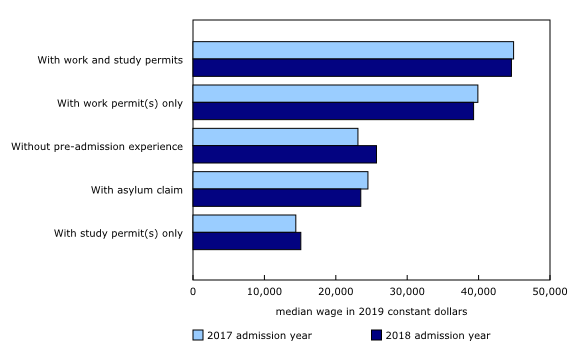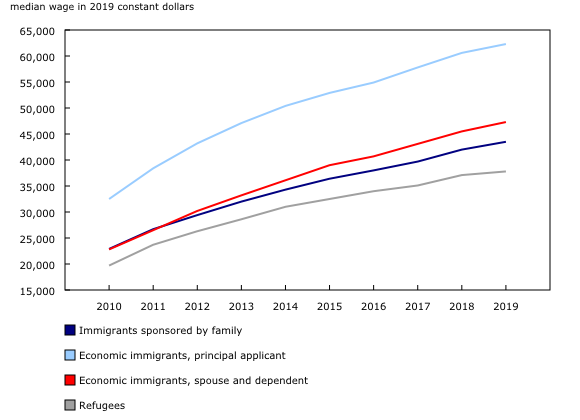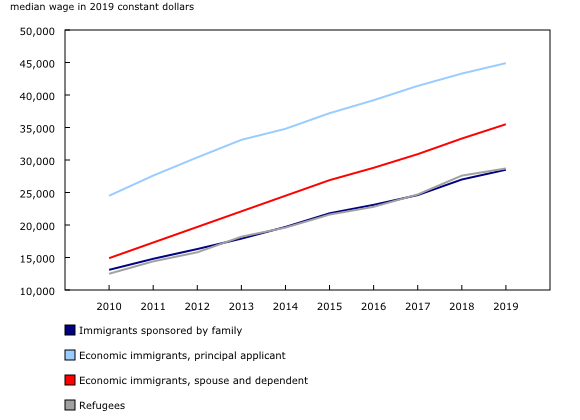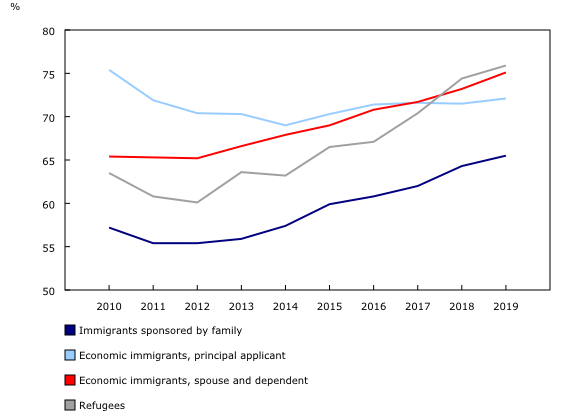Longitudinal Immigration Database: Immigrants' income trajectories during the initial years since admission
Archived Content
Information identified as archived is provided for reference, research or recordkeeping purposes. It is not subject to the Government of Canada Web Standards and has not been altered or updated since it was archived. Please "contact us" to request a format other than those available.
Released: 2021-12-06
The COVID-19 pandemic has impacted the lives of Canadian immigrants in many ways. To assess these impacts, it is important to know where Canadian immigrants stood economically right before the outbreak of the pandemic. Based on the latest available data from the 2020 Longitudinal Immigration Database (IMDB), the present article serves this goal by focusing on immigrant wages in recent years, including 2019. This will provide a baseline for comparison once data for 2020 are available.
Immigrants admitted to Canada in 2018 had a median wage of $31,900 in 2019. This was 4.2% higher than the median entry wage of immigrants admitted in 2017 ($30,600). In fact, immigrants admitted in 2018 had the highest median entry wage, reported one year after admission, among all immigrants admitted since 1981. Despite that, their median wage was still 17.8% lower than the 2019 median wage of the total Canadian population ($38,800).
Compared with those admitted in 2017, immigrants admitted in 2018 experienced median entry wage increases in all provinces, except Alberta, and Newfoundland and Labrador. A closer look by immigration category and pre-admission experience sheds light on differences among various groups of immigrants admitted in 2018, compared with their counterparts admitted in 2017 as well as the Canadian population in corresponding years.
Median wage of economic immigrant principal applicants surpasses that of the Canadian population one year after admission
Principal applicants of economic categories are selected for their ability to be integrated into the Canadian labour market and to contribute to the economy. Most of them have post-secondary education and knowledge of at least one official language. Immigrants admitted under those categories in 2018 had a median wage of $43,600 in 2019, 12.4% higher than the Canadian median wage in the same year ($38,800) and 3.8% higher than the median entry wage of their counterparts admitted in 2017 ($42,000).
While the median wage of economic principal applicants surpassed that of the Canadian population one year after admission, those of all other immigrants were still less than the Canadian median wage.
The median entry wage of economic immigrant dependents admitted in 2018, spouses included, was $27,600. While lower than the 2019 Canadian median wage, this number was 7.0% higher than that of their counterparts admitted in 2017 ($25,800).
There was no change in the median entry wage between family sponsored immigrants admitted in 2017 and 2018 ($24,500). The median entry wage of refugees ($19,200) was the lowest among immigrants admitted in 2018, though it was 2.7% higher compared with that of their counterparts admitted in 2017 ($18,700).
Economic principal applicants are selected on the basis of their education, specific skills and work experience. The vast majority (96.1%) of immigrant taxfilers admitted under this category in 2018 had completed some post-secondary education at the time of their admission. Economic principal applicants are also more likely to have pre-admission experience in Canada. Among those admitted under this category in 2018, almost two-thirds (64.5%) of them had pre-admission experience in Canada, in contrast with their counterparts admitted as refugees (33.3%), through family sponsorship (32.7%), or as dependents of economic immigrants (32.6%).
High median wages one year after admission are associated with work-related pre-admission experience in Canada
Pre-admission experience in Canada, particularly work-related, plays an important role in lifting immigrants' wages, as it provides a pathway for immigrants to acquire language skills and knowledge of the Canadian labour market. Immigrant taxfilers having both study and work permits prior to immigration obtained the highest median wage one year after admission, both for those admitted in 2017 ($44,900) and in 2018 ($44,600). Immigrants only having work permits prior to immigration obtained the second highest median wage one year after admission ($39,900 for those admitted in 2017 and $39,300 for the 2018 admission cohort). Immigrants admitted with pre-admission work-related experience in 2017 and 2018 already had median wages higher than those of the Canadian population in 2018 ($38,200) and 2019 ($38,800), respectively.
Immigrants without pre-admission experience had lower median entry wages than immigrants with Canadian work experience prior to their admission. Their median entry wage was $23,100 for those admitted in 2017 and $25,700 for those admitted in 2018.
Among immigrants with pre-admission experience in Canada, those with study permits only prior to admission had the lowest median entry wages in 2018 ($14,400) and 2019 ($15,100). However, this group of immigrants is on average younger than their counterparts in all other groups, and therefore has a strong potential to increase their earnings as their careers unfold in the Canadian labour market. Furthermore, they are also more likely to have part-time jobs; information about whether or not their employment was full-time, full-year is unavailable.
Median wages increase over time with different outcomes for men and women according to their immigration category
When tracking changes over time, a focus on immigrant men and women admitted at age 18 or older in 2009 shows that median wages increased across all immigration categories and for both men and women from 2010 to 2019. However, such increases benefited immigrant men and women differently.
Both economic principal applicant men and women admitted in 2009 had median wages far above those of their counterparts in all other categories throughout the 10-year period. The median wage of men nearly doubled, from $32,500 in 2010 to $62,300 in 2019, with an average annual increase rate of 10.2%. The median wage of their woman counterparts nearly doubled as well, from $24,500 to $44,900 over the same period, with an average 9.3% annual increase. Among economic principal applicants, women's median wage started lower than men's and men's median wage increased faster than women's. As a result, the median wage gap widened between men and women over time in favour of men.
The opposite pattern is observed among all other immigration categories. Although women's median wage was even lower than men's within each of those categories, it increased faster than men's. During the 10-year observational period, men's median wage increased among economic dependents, refugees, and family sponsored immigrants with average annual increase rates of 11.9%, 10.2% and 10.0%, respectively. The average annual rates of increase for women were 15.4%, 14.4% and 13.1%, respectively, for economic dependents, refugees and family sponsored immigrants. With women's higher increase rates of their median wages, the median wage gap narrowed between men and women within each of those immigration categories over time in favour of women.
Pay ratio of immigrant women versus men increases over time for all immigration categories except economic principal applicants
Pay disparity between women and men is an important social, economic, and political issue. As immigration aims to respond to Canada's need for labour supply, the gender parity and successful settlement of women in the labour market is key to achieving Canada's objectives. To measure the median gender pay ratio, the median annual wages, salaries and commissions of women were divided by the median annual wages, salaries and commissions of men.
From 2010 to 2019, the gender pay ratio for Canadians increased from 67.9% to 72.6%. Among immigrants admitted as adults in 2009, the gender pay ratio followed a similar pattern: 65.5% in 2010 compared with 69.6% in 2019. The gender pay ratio, however, differed by immigration category during this period.
The increasing gender pay ratio was seen in all immigration categories, except economic principal applicants. From 2010 to 2019, the gender pay ratio increased from 57.2% to 65.5% among family sponsored immigrants, from 65.4% to 75.1% among dependents of economic immigrants, and from 63.5% to 75.9% among refugees.
For economic principal applicants, however, the gender pay ratio slightly decreased from 75.4% in 2010 to 72.1% in 2019. Further analysis would be required to understand the reasons behind this trend.
Within immigration categories, the wage gap between women and men decreased overtime, except for economic principal applicants. Although the median wage of economic principal applicant women increased greatly over time, their man counterparts had a larger increase, resulting in a widening of the median wage gap between immigrant women and men.
This article is the first part of a two-part series about recent immigrants' outcomes using data from the Longitudinal Immigration Database. The second part will discuss immigrants' mobility.
Note to readers
Definitions and concepts
The Longitudinal Immigration Database (IMDB) is a comprehensive source of data that plays a key role in the understanding of the economic behaviour of immigrants and non-permanent residents. It is the only annual Canadian dataset that allows users to study the characteristics of immigrants to Canada at time of admission and the economic outcomes and regional mobility of immigrants over a period of more than 35 years.
The IMDB is the result of a partnership between Statistics Canada, Immigration, Refugees and Citizenship Canada (IRCC), and the provinces. The IMDB combines administrative files on immigrant admissions and non-permanent resident permits from IRCC with tax files from the Canada Revenue Agency (CRA). IRCC's administrative records contain extensive information on immigrants admitted to Canada since 1952. They also include information on non-permanent residents who have been granted a temporary resident permit since 1980. Fiscal data are available from the CRA's tax files for immigrant taxfilers admitted since 1980. Tax records for 1982 and subsequent years are available for immigrant taxfilers.
The IMDB links short-term and long-term outcomes to characteristics at admission, such as immigrant admission class, country of origin and knowledge of official languages. The IMDB also provides information on pre-admission experience in Canada and citizenship acquisition since 2005.
For additional information regarding the data coverage and data quality of the IMDB, users should refer to the 2020 Longitudinal Immigration Database technical report.
Note that the IMDB is updated annually. From year to year, there have been changes to data processing. Each yearly update is independent.
This release analyzes income based on the medians of wages (for the population with wages, salaries or commissions income, excluding self-employment income). The median is the income threshold at which a half of the immigrant taxfilers have higher income and the other half have lower. Zero values are not included in the calculation of medians for individuals. All income estimates are expressed in 2019 constant dollars to factor in inflation and enable comparisons across time in real terms.
Median entry wage in this analysis is measured as the median wages reported one year after admission to Canada as permanent residents.
The median gender pay ratio in wages, salaries and commissions is the median annual wages, salaries and commissions for women divided by the median annual wages, salaries and commissions for men. The gender pay ratio can be interpreted as the proportion of a dollar that women earn for every dollar earned by men.
Economic immigrant admission categories include immigrants who have been selected for their ability to contribute to Canada's economy through their ability to meet labour market needs, to own and manage or to build a business, to make a substantial investment, to create their own employment or to meet specific provincial or territorial labour market needs.
Immigrant sponsored family categories include immigrants who were sponsored to come to Canada by a family member who is a Canadian citizen or permanent resident.
Refugee categories include immigrants who were granted permanent resident status on the basis of a well-founded fear of returning to their home country. These include government-assisted refugees, privately-sponsored refugees, refugees admitted in Canada, and their dependents.
Principal applicant is the person submitting the immigration application and the individual being assessed on admission criteria under each of the admission categories, while their accompanying spouse and dependents are admitted automatically with the principal applicant.
Taxfilers are immigrants and asylum claimants who have filed a tax return for a given taxation year.
For a more detailed description of the immigrant admission classes, see the IRCC Glossary.
Source on income of the Canadian population:
Source on gender ratio of the Canadian population: Table 14-10-0324-01 Average and median gender pay ratio in annual wages, salaries and commissions. Immigrants are included in the data presented.
Source for Canadian median income: Table 11-10-0239-01 Income of individuals by age group, sex and income source, Canada, provinces and selected census metropolitan areas.
Products and dissemination of the 2020 Longitudinal Immigration Database
The data visualization tool "Longitudinal Immigration Database (IMDB) Interactive Application: Economic Outcomes".
The publication "Longitudinal Immigration Database (IMDB) Technical Report, 2020" is available in PDF or HTML format.
Products
The data visualization tool "Longitudinal Immigration Database (IMDB) Interactive Application: Economic Outcomes" is now available as part of the series Statistics Canada - Data Visualization Products (71-607-X).
The publication "Longitudinal Immigration Database (IMDB) Technical Report, 2020" is now available.
The products are available on the Immigrant and Non-Permanent Resident Statistics Portal. The Portal was designed to provide easy and free access to immigrant and non-permanent resident data and publications. Information is organized into broad categories including analytical products, data products, reference materials and interactive applications.
The Longitudinal Immigration Database 2020, including the wages and salary module (1997 to 2020), is now available upon request.
Contact information
For more information, or to enquire about the concepts, methods or data quality of this release, contact us (toll-free 1-800-263-1136; 514-283-8300; infostats@statcan.gc.ca) or Media Relations (statcan.mediahotline-ligneinfomedias.statcan@statcan.gc.ca).
- Date modified:





